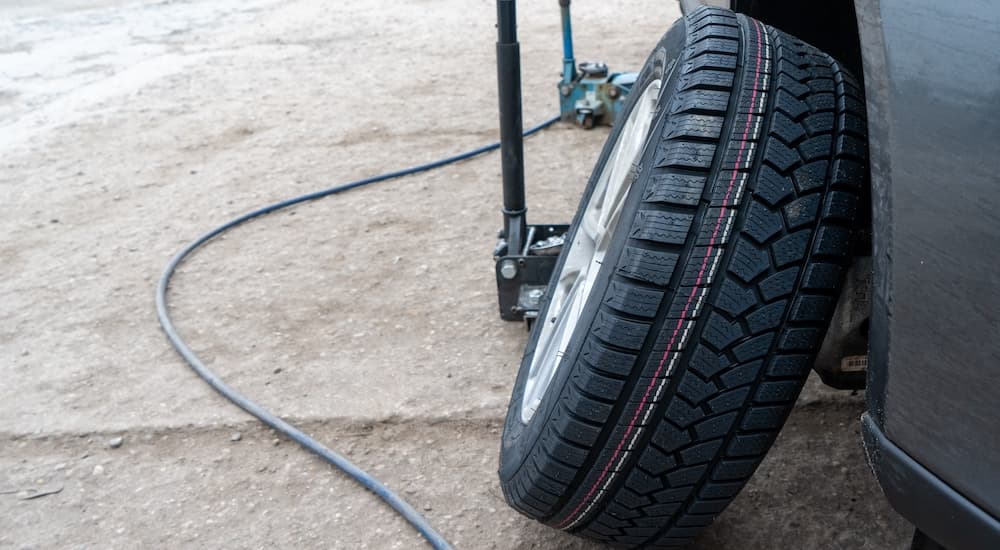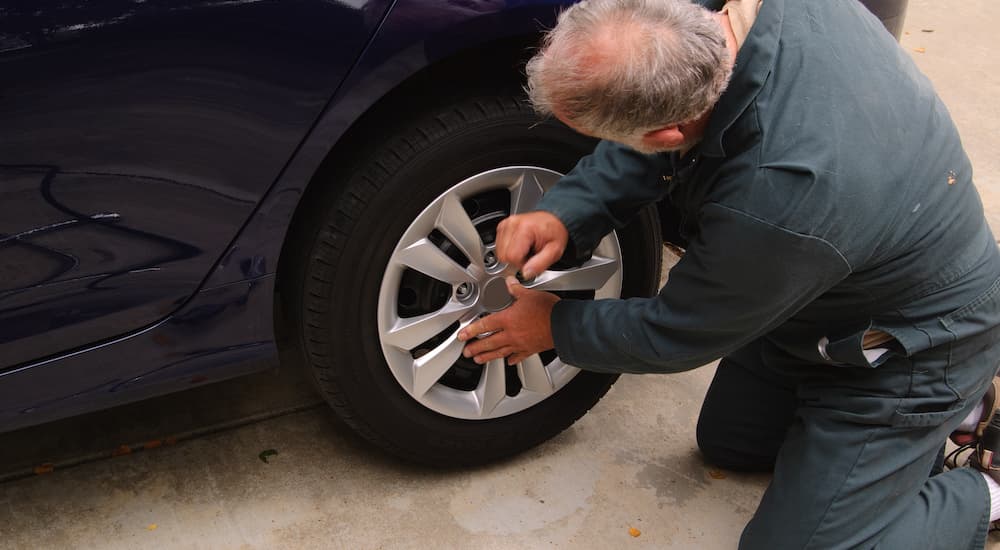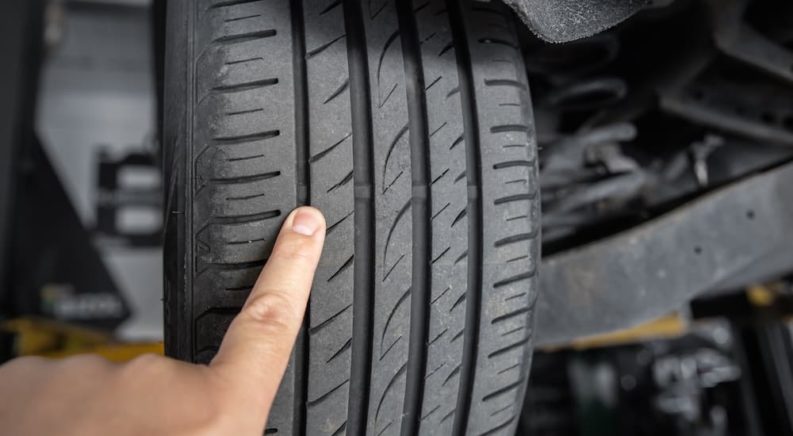If you’ve ever had your car serviced and the technician gave you a breakdown of what was performed, a tire rotation will likely be on it. Between the many twists and turns of your travels, some of your tires just suffer wear and tear at a faster rate than others. Rotating them means changing the location of the tires on your vehicle, which gives them a chance to balance out the wear patterns. Different experts have different opinions on how often you should rotate your tires. Depending on which dealership or tire shop you ask, some say as often as every 3,000 miles, while others say you can go up to 7,500 miles before rotating your tires.
Failing to rotate your tires regularly can lead some to wear down quicker than others. This can cause unsafe driving conditions and even put you at risk of bad traction on slippery and icy roads. Tire rotations aren’t expensive; they typically range from $25 to $50. However, that’s $50 you could have put towards a date night or into your emergency savings. And you don’t just give your money when you visit a body shop; you also give your time. So, if you can learn how to rotate your own tires, you’ll save both money and time. Plus, you’ll feel a greater sense of independence. Here is how to do so safely:
The Tools You’ll Need
Before you get started, there are some tools that you will need to do this safely and like a pro. They are as follows:
Lug wrench
You’ll use a lug wrench to loosen and tighten the nuts that hold the tires in place on the car. Look for a four-sided one, as these are the most versatile and will work with most nut sizes.
Car jack
You’ll need a hydraulic car jack, not just the small one that comes with a car kit. A hydraulic car jack can actually hold the weight of the car when you get the proper size. Speak to an autobody shop about the right car jack for your car.
Jack stands
You cannot put the full weight of your vehicle on the lip of the car jack. You will need jack stands to put under the vehicle and offer proper support. These typically come in a set of two, and it is extremely important to buy the correct size so that it can support your vehicle’s weight.

Preparing Your Vehicle for Tire Rotation
There are some things that are important to do before you get started. First, park on level ground. Do not park on any incline, even the slightest, and do not park on rough ground like gravel or stones. It’s best to park on a perfectly even surface like cement or asphalt. Put on the emergency brake, and put a block or wedge beneath the tire you’ll start on. Next, loosen the lug nuts on the first tire but do not remove them. Get the hydraulic jack into position underneath the car frame beside the first tire you’ll rotate out. Now you’re ready to begin.
How to Rotate the Tires
Now that your car is in position, pump the handle of the jack to lift it until it touches the car’s frame. Then raise the car just enough to get the first tire off the ground. Now you can remove the nuts you loosened earlier and take the tire off. Continue to lift the car until the height of the jack stand has been cleared. Get the jack stand in the proper position beneath the car and lower the vehicle to rest on the jack stand. Then lock the stand into place.
Repeat this process on the other side of the car. Lift the car next to the second tire to be rotated out; the one going into the position of the first that was removed. Take off the second tire and put it in the first tire’s position. Be sure to put it securely over the wheel bolts. Replace the lug nuts, and tighten these just with your hands; then, you can use your wrench to secure the bolts, but not too tight yet.
Raise the vehicle to clear the height of the jack stand, remove the jack stand, and lower the car. Now you will use the lug wrench to tighten the nuts and bolts. For the bolts, you’ll move in a star-like shape. So start with the one top and center. Then go directly across it, bottom and center. Then go to the left mid-height bolt. Then go directly across from that to the bolt on the right of the tire. Repeat this process for all tires until each one has been rotated.

Directional vs. Non-directional Tires
Your car will have one of two types of tires: directional or non-directional. Directional tires are made to only rotate in one direction (i.e. left or right). There will be an arrow on them indicating in which direction they can turn. Naturally, when you have directional tires, they have to stay on their respective side of the car. That means you’ll rotate the front right tire to the rear right, and the rear right will go up to the front right. Likewise, on the left side, during a rotation, the front tire will move to the rear left, and the rear left will go up to the front left.
Never shall directional tires switch sides of the vehicle. Because of the limited rotational positions of these tires, they are the easiest to rotate but also suffer a shorter lifespan than non-directional tires. There is one last note on directional tires: on some cars, the front tires are a different size from the rear ones. If that is the case on your car, then tire rotations cannot be performed, and you must simply replace the tires in a timely manner.
Non-directional tires have a tread specifically designed to perform well on various surfaces, in every position of the vehicle, and can also turn in any direction. Because they can be rotated to various positions on the vehicle, they have a longer life than directional tires. The direction you rotate these tires is a bit more complicated than with directional tires.
It goes as follows:
- Rotate the rear left tire to the front left position.
- Rotate the front left tire to the rear right position.
- Rotate the rear right tire to the front right position.
- Rotate the front right tire to the rear left position.
Should your car be a front-wheel drive one, reverse the instructions above:
- Rotate the front left tire to the rear left position.
- Rotate the front right tire to the rear right position.
- Rotate the rear left tire to the front right position.
- Rotate the rear right tire to the front left position.
A Valuable Maintenance Skill That Can Save You Time and Money
Learning to rotate your tires can be intimidating at first. It is a good idea to watch a professional do it before you do it yourself, and be sure you are completely comfortable with all of your tools before you begin. Once you get the hang of it, you’ll be glad you don’t need to schedule an appointment, drive into a dealership or auto body shop, and pay someone else to do it for you.
It’s easy to overlook the importance of tire rotation. Because of your driving patterns, some tires will naturally get more use than others, and over time, if they aren’t rotated out, they’ll thin out faster than the others. Tire rotation is an important part of taking good care of your car; luckily, it can be done from home. Just be sure to take all proper safety precautions, know what types of tires you have, and buy the right equipment for your car and tire type.

